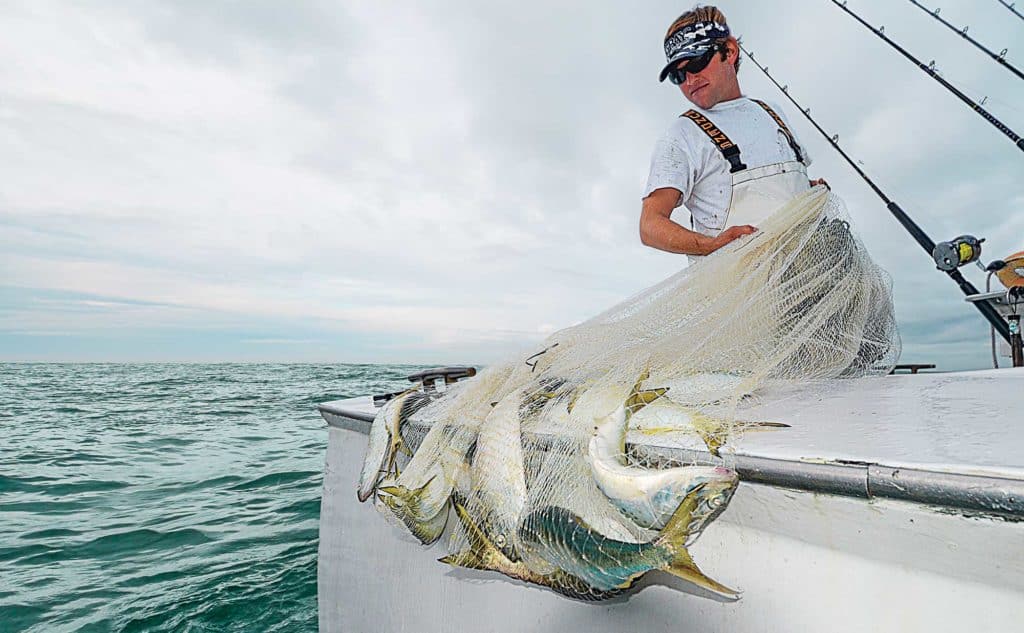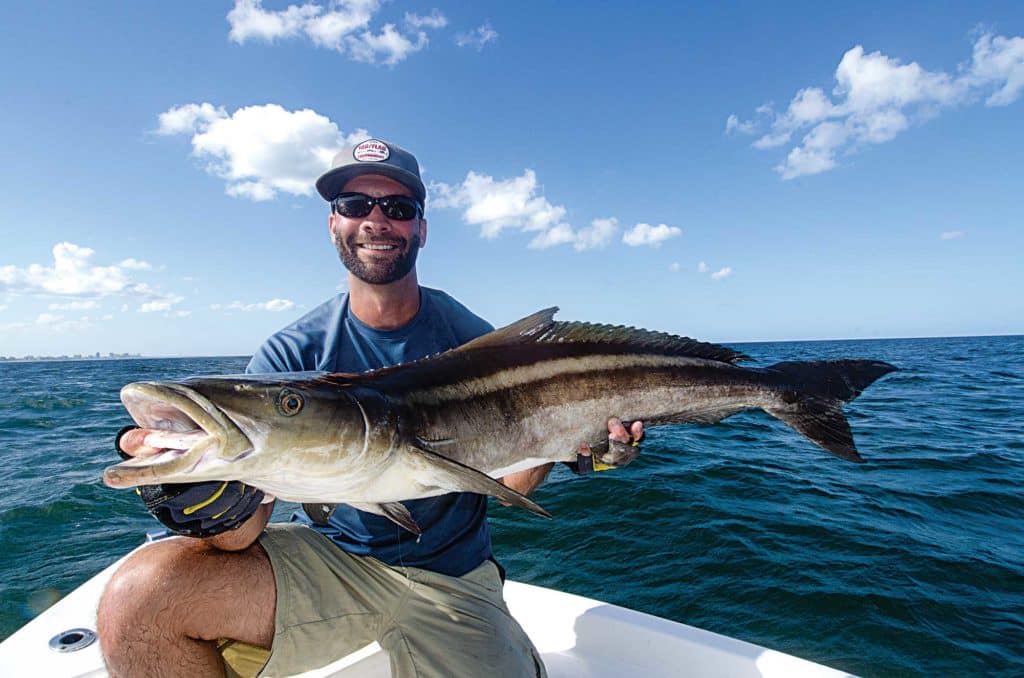
Perched atop the sight-fishing tower, Capt. Ben Shepherd ran his 24-foot bay boat along the Virginia Beach oceanfront, looking for bait, turtles, rays or cobia swimming just below the surface.
Soon we found a target, a 4-foot-long fish snaking along, unaware of our attention. Shepherd threw a bucktail. No answer. Then he threw a live eel. The cobia turned, grabbed the eel by the tail, and yanked it off the hook. “Damn, fish are getting smarter!” he laughed. Next, he lobbed a live menhaden and bingo — the cobia engulfed the bait and headed for the deep.
“Don’t show this to anyone,” Shepherd winked at me as he battled the cobia. I winked back; he knows his secrets aren’t safe with me.
Chocolate Lover
Most anglers who sight-cast for cobia don’t use menhaden, but Shepherd had stashed a dozen in the bait box. A 3-ounce bucktail offers the best casting accuracy, but it’s hard to beat a livey for finicky fish. And while a wiggling eel is a proven follow-up to the jig, not many cobia will pass up a bunker.

Cobia Rig
2. Zip tie through eye socket
3. 4 feet of 80-pound fluoro
4. No-name knot
5. Bimini twist
6. 50-pound braided main line Push a zip tie through the bait’s eye socket and tighten around the top of the head. Slide an 8/0 circle hook through the zip tie. Snell the hook to 4 feet of 80-pound fluorocarbon. Use a Bimini to a no-name knot to secure the leader to 50-pound braided main line. Steve Sanford
“Cobia will zone in on bunker,” the captain explains. “Watching a trophy fish turn down everything in the tackle box is maddening; many times a fresh bunker is the only solution. They are particularly effective at drawing shy cobia off a buoy or convincing a hesitant fish to come back for a bite. A live one is the best choice, but a dead menhaden will work in a pinch.”
Game-Fish Candy
Atlantic menhaden, also commonly known as bunker, pogy and fatback, ranges from Jupiter Inlet, Florida, north to Nova Scotia. It’s an essential member of important ecosystems throughout the western Atlantic and one of the most important sources of forage for a wide array of game fish.

Tarpon Rig
2. Haywire twist
3. 18 inches of 90-pound single-strand wire
4. 150-pound swivel
5. Tie 10 feet of double line from a Bimini twist on the main line to 6 feet of 30- to 60-pound fluorocarbon with a uni-knot Tie a Bimini twist with 10 feet of double line and use a double uni-knot to attach it to 6 feet of 30- to 60-pound fluoro, tied to a 150-pound swivel. With Haywire twists, connect 18 inches of 90-pound single-strand wire to the swivel and a 5/0 circle hook. Then run the hook through the pogy’s nose. Steve Sanford
From spring through fall, these silver and gold baitfish move en masse along the East Coast of the U.S., sparking terrific action along the way with a number of popular species, including striped bass, bluefish, cobia, king mackerel, tarpon and more. So carrying a supply of menhaden on board is a surefire way to increase your odds of success.
King-Maker
No one worships menhaden more than anglers on the king mackerel tournament trail, where using the right bait translates into trophy kings and big paychecks. According to Capt. Dave Wicker of Wilmington, North Carolina, “Finding the bait is often the hardest part, and side-scan sonar comes in handy.” To preserve the bait’s slime coat and color, he uses a 40-gallon livewell with two 1,500 gph pumps. “We pressurize the livewell by sealing the lid and adjusting the water flow to keep the baits from sloshing around.”

Kingfish Rig
2. 4 feet of No. 4 single-stand wire
3. 1/0 live-bait hook through the nose
4. 4 inches of single-strand wire
5. No. 4 treble, fixed at anal fin
6. Second treble swings freely Haywire-twist 4 feet of No. 4 single-strand wire to an 80-pound barrel swivel and to a 1/0 live-bait hook at the other end. Twist 4 inches of wire, attached to a No. 4 treble hook, to the eye of the single hook. Attach a second treble to another 4-inch piece of wire twisted to the eye of the first treble. Steve Sanford
Wicker deploys a half-dozen live menhaden and trolls just fast enough to keep the boat ahead of the baits. He runs two baits off downriggers, dropping the downrigger balls so they’re just above where he marks fish on the fish finder. He also pulls two baits off the outriggers, 40 to 50 yards back, another in the prop wash, and the last bait 100 yards behind the boat. “The shortest and longest baits are generally most productive,” Wicker adds.
The skipper also uses menhaden for chum. “Some guys grind fresh menhaden on the water,” he says, “but that attracts sharks and barracuda.” Instead he drips menhaden oil into the water using a 4-foot length of 2-inch PVC pipe with a valve on one end to control the oil drip rate. Too much oil also attracts unwanted predators, Wicker says, so he keeps the drip just fast enough to create a sheen on the surface.

Pogies for Poons
As spring turns to summer, schools of Atlantic menhaden gather at the southern end of their range, off east central Florida. Capt. Tom Van Horn waits off the St. Johns River to meet them. “May through July, the seas are calm, and it’s easier to chase the bait,” he says.
Van Horn starts the day looking for schools of menhaden on the surface. “We may run 20 miles to find bait,” he explains. He starts within a few miles off the beach, behind the surf line, where he can catch menhaden with a cast net. Once he has two or three dozen baits, it’s time to look for tarpon. He cruises around, keeping an eye out for tarpon rolling or jumping, or birds working over bait. “I find the best fishing around isolated baitballs,” he says, “away from the concentrations of menhaden where I catch the bait.”
Read Next: How to Hook Live Bait
When Van Horn spots telltale signs, he turns off the outboard, engages the trolling motor, and slow-trolls two live menhaden just fast enough to keep the baits swimming. He uses two heavy-action casting or spinning combos with 30-pound braided line and keeps a third spinning rod ready with a pitch bait. “Trolling more than two rods causes trouble when a tarpon hits,” he explains. “There’s too much chaos to clear more than one line.”
Van Horn rigs all three rods the same way: a Bimini twist on the end of the main line, with 10 feet of double line tied to a 30- to 60-pound fluorocarbon leader. He attaches a swivel to the fluorocarbon and then adds a trace of 90-pound single-strand wire leader, and finishes with a 5/0 circle hook. “I use a long double line to make it easier to handle the fish boatside,” he explains. He hooks the menhaden through the nose and fishes one 50 feet behind the boat and the other 75 feet back.
When a tarpon hits the bait, Van Horn lets the rod holder set the hook. “I set the drag light, and the circle hook finds its way into the corner of the tarpon’s mouth.” Once the fish is hooked and running, he cranks up the outboard and gives chase.
Snag and Drop
Big striped bass also love menhaden, and when the bait schools are thick along the beaches and the stripers are lurking right underneath them, a tactic known as snag and drop works quite well. “Snag and drop isn’t brain surgery,” explains Rhode Island charter skipper Capt. Jack Sprengel. “Cast a weighted treble hook into a school of menhaden, snag a bait, let it sink and hold on tight. If the fish are aggressive and deep-hooking stripers is a concern, reel in the snagged bait, transfer it to another outfit rigged with a single hook, and fling it back out.”

Snag and Drop
2. 6 feet of 30-pound fluoro
3. FG knot, 30-pound braid to leader Uni-knot a 7/0 weighted treble hook to 6 feet of 30-pound fluorocarbon leader. Then attach the leader to 30-pound braided main line with an FG knot. Steve Sanford
Sprengel claims that as fishermen learn a new tactic, the fish seem to get smarter. “We used to run to the north end of the bay to catch a handful of menhaden, then head to the south bay to find striped bass. Today, menhaden are easy to find, but the stripers have become more discerning. Many of the fish can’t be fooled with a bunker that’s been in a livewell. They just won’t eat a bait that’s lost its coat of slime or is discolored.”
Read Next: Fishing With Live Bait
As a result, some anglers along New England have taken to snagging a bunker out of a school and then letting it drop to the fish. “Getting your bait away from its schoolmates and down deep where the big bass await works best,” Sprengel says.
He first checks the direction a bunker school is heading, then pulls ahead of it and orders his anglers to cast into the school to snag a bait and fish it. When that doesn’t work, he’ll have them cast live bunker into the school, letting the bait slap the surface to wake up the bass. “That often pays off big in early spring, when I’m fishing on the flats in the morning.”









